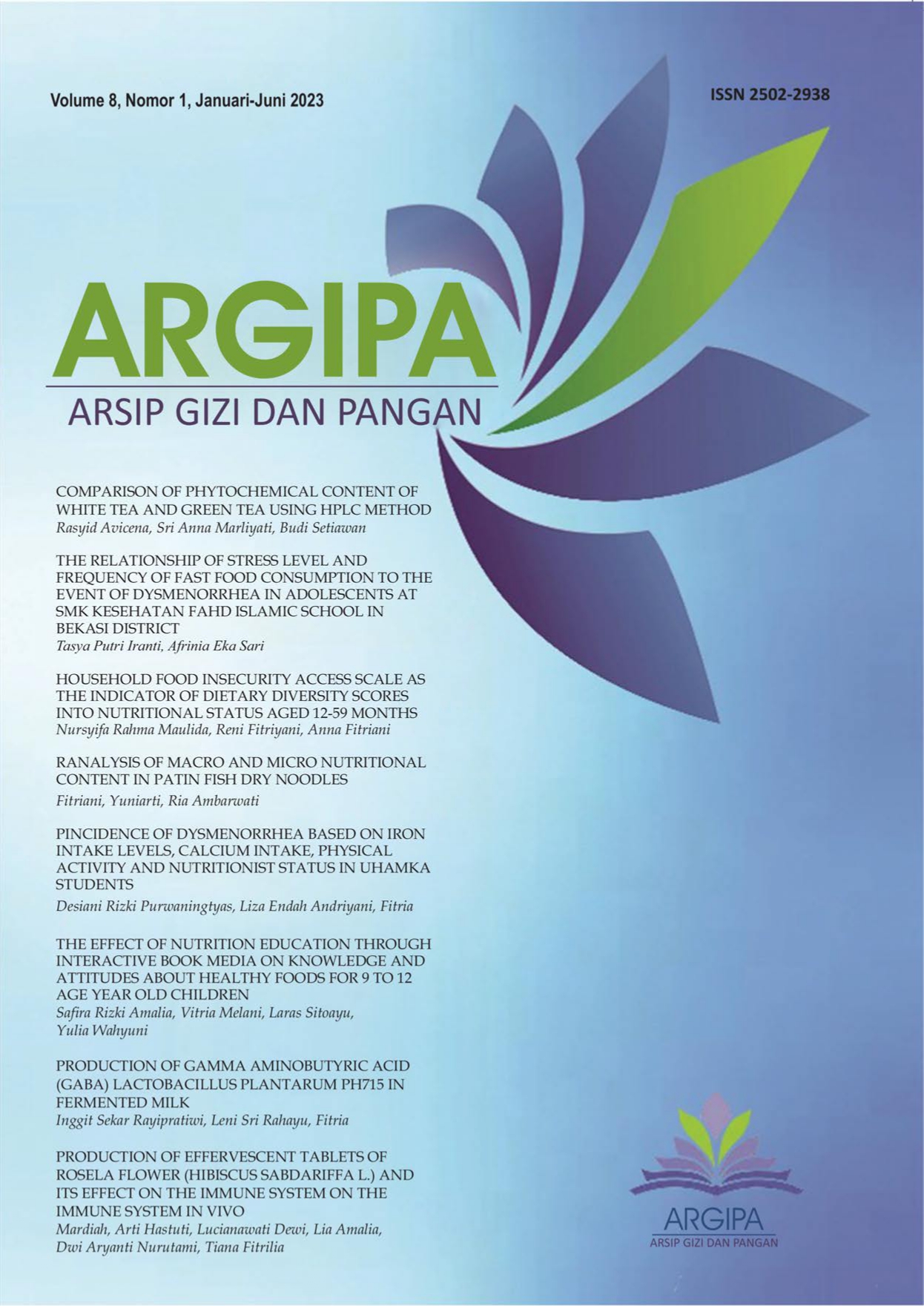Production of gamma aminobutyric acid (Gaba) Lactobacillus plantarum PH715 in fermented milk
DOI:
https://doi.org/10.22236/argipa.v8i1.8369Keywords:
GABA, Lactobacillus plantarum, Fermented milkAbstract
Fermentation has a great potential to increase gamma amynobutiric acid (GABA) content, one of which is fermented milk. In particular, fermentation by lactic acid bacteria can produce GABA in its most natural and suitable form. The purpose of this study was to examine the potential of Lactobacillus plantarum PH715 to produce GABA as a starter for fermented milk. Temperature and incubation time are factors that affect the production of GABA in fermented milk. The pH measurement with pH meter, population with scatter method, GABA content produced was analysed quantitatively using UPLC. Based on the observation, L. plantarum PH715 is a gram-positive bacteria, bacil-shaped, purple in colour, catalase negative and does not produce gas. The pH value at the fermentation time of 48 hours with a temperature of 37°C and 43°C has met the pH requirements as fermented milk, which are 4.21 and 4.25. The population of L. plantarum PH715 at incubation times of 0, 12, 24, 36 and 48 hours at temperatures of 37°C and 43 °C met the probiotic requirements. The highest GABA content of fermented milk by L. plantarum PH715 was at an incubation temperature of 37°C for 48 hours with the addition of 2% MSG at 2.09mg/mL.Downloads
Download data is not yet available.
References
Anggraini, L., Marlida, Y., Wizna, W., Jamsari, J., & Mirzah, M. (2019). Optimization of nutrient medium for Pediococcus acidilactici DS15 to produce GABA. Journal of World's Poultry Research, 9(3), 139–146. https://doi.org/10.36380/jwpr.2019.17
Askar, S."¯;Sugiart. (2005). Uji Kimiawi dan Organoleptik Sebagai Uji Mutu Yogurt. Prosiding Temu Teknis Nasional Tenaga Fungsional Pertanian, 118–113.
Cho, Y. R., Chang, J. Y., & Chang, H. C. (2007). Production of γ-aminobutyric acid (GABA) by Lactobacillus buchneri isolated from Kimchi and its neuroprotective effect on neuronal cells. Journal of Microbiology and Biotechnology, 17(1), 104–109. https://doi.org/10.1271/nogeikagaku1924.61.1449
Di Cagno, R., Mazzacane, F., Rizzello, C. G., De Angelis, M., Giuliani, G., Meloni, M., De Servi, B., & Gobbetti, M. (2010). Synthesis of γ-aminobutyric acid (GABA) by Lactobacillus plantarum DSM19463: Functional grape must beverage and dermatological applications. Applied Microbiology and Biotechnology, 86(2), 731–741. https://doi.org/10.1007/s00253-009-2370-4
Diana, M., Quílez, J., & Rafecas, M. (2014). Gamma-aminobutyric acid as a bioactive compound in foods: A review. Journal of Functional Foods, 10, 407–420. https://doi.org/10.1016/j.jff.2014.07.004
Feehily, C., & Karatzas, K. A. G. (2013). Role of glutamate metabolism in bacterial responses towards acid and other stresses. Journal of Applied Microbiology, 114(1), 11–24. https://doi.org/10.1111/j.1365-2672.2012.05434.x
Fernández, M., & Zúñiga, M. (2006). Amino acid catabolic pathways of lactic acid bacteria. Critical Reviews in Microbiology, 32(3), 155–183. https://doi.org/10.1080/10408410600880643
Franciosi, E., Carafa, I., Nardin, T., Schiavon, S., Poznanski, E., Cavazza, A., Larcher, R., & Tuohy, K. M. (2015). Biodiversity and γ -aminobutyric acid production by lactic acid bacteria isolated from traditional alpine raw cow's milk cheeses. BioMed Research International, 2015. https://doi.org/10.1155/2015/625740
Gonzalez-Gonzalez, C. R., Machado, J., Correia, S., McCartney, A. L., Stephen Elmore, J., & Jauregi, P. (2019). Highly proteolytic bacteria from semi-ripened Chiapas cheese elicit angiotensin-I converting enzyme inhibition and antioxidant activity. Lwt, 111(December 2018), 449–456. https://doi.org/10.1016/j.lwt.2019.05.039
Harnentis, H., Nurmiati, N., Marlida, Y., Adzitey, F., & Huda, N. (2019). Aminobutyric acid production by selected lactic acid bacteria isolate of an Indonesian indigenous fermented buffalo milk (dadih) origin. Veterinary World, 12(8), 1352–1357. https://doi.org/10.14202/vetworld.2019.1352-1357
Huang, Y., Su, L., & Wu, J. (2016). Pyridoxine supplementation improves the activity of recombinant glutamate decarboxylase and the enzymatic production of gama-aminobutyric acid. PLoS ONE, 11(7), 1–18. https://doi.org/10.1371/journal.pone.0157466
Kailasapathy, K., Sultana, K. , Godward, G. (2000). Probiotic Bacteria: Improved Delivery by Bioencapsulation Probiotica. J. Dairy Technology, 9, 2–7.
Komatsuzaki, N., Shima, J., Kawamoto, S., & Momose, H. (2005). ARTICLE IN PRESS Production of g -aminobutyric acid ( GABA ) by Lactobacillus paracasei isolated from traditional fermented foods. 22, 497–504. https://doi.org/10.1016/j.fm.2005.01.002
Li, H., Li, W., Liu, X., & Cao, Y. (2013). gadA gene locus in Lactobacillus brevis NCL912 and its expression during fed-batch fermentation. FEMS Microbiology Letters, 349(2), 108–116. https://doi.org/10.1111/1574-6968.12301
Li, H., Qiu, T., Huang, G., & Cao, Y. (2010). Maani Otsirinkakara. 1–7.
Li, W., Wei, M., Wu, J., Rui, X., & Dong, M. (2016). Novel fermented chickpea milk with enhanced level of γ -aminobutyric acid and neuroprotective effect on PC12 cells. PeerJ, 2016(4), 1–20. https://doi.org/10.7717/PEERJ.2292
Lin, Q. (2013). Submerged fermentation of Lactobacillus rhamnosus YS9 for γ-aminobutyric acid (GABA) production. Brazilian Journal of Microbiology, 44(1), 183–187. https://doi.org/10.1590/S1517-83822013000100028
Lu, X., Chen, Z., Gu, Z., & Han, Y. (2008). Isolation of γ-aminobutyric acid-producing bacteria and optimization of fermentative medium. Biochemical Engineering Journal, 41(1), 48–52. https://doi.org/10.1016/j.bej.2008.03.005
Minervini, F., Bilancia, M. T., Siragusa, S., Gobbetti, M., & Caponio, F. (2009). Fermented goats' milk produced with selected multiple starters as a potentially functional food. Food Microbiology, 26(6), 559–564. https://doi.org/10.1016/j.fm.2009.03.008
Miura, D., Ito, Y., Mizukuchi, A., Kise, M., Aoto, H., & Yagasaki, K. (2006). Hypocholesterolemic action of pre-germinated brown rice in hepatoma-bearing rats. Life Sciences, 79(3), 259–264. https://doi.org/10.1016/j.lfs.2006.01.001
Nejati, F., Rizzello, C. G., Di Cagno, R., Sheikh-Zeinoddin, M., Diviccaro, A., Minervini, F., & Gobbetti, M. (2013). Manufacture of a functional fermented milk enriched of Angiotensin-I Converting Enzyme (ACE)-inhibitory peptides and γ-amino butyric acid (GABA). LWT - Food Science and Technology, 51(1), 183–189. https://doi.org/10.1016/j.lwt.2012.09.017
Park, K. B., & Oh, S. H. (2007). Production of yogurt with enhanced levels of gamma-aminobutyric acid and valuable nutrients using lactic acid bacteria and germinated soybean extract. Bioresource Technology, 98(8), 1675–1679. https://doi.org/10.1016/j.biortech.2006.06.006
Park, S. Y., Lee, J. W., & Lim, S. D. (2014). The probiotic characteristics and GABA production of Lactobacillus plantarum K154 isolated from kimchi. Food Science and Biotechnology, 23(6), 1951–1957. https://doi.org/10.1007/s10068-014-0266-2
Ratanaburee, A., Kantachote, D., Charernjiratrakul, W., & Sukhoom, A. (2013). Selection of γ-aminobutyric acid-producing lactic acid bacteria and their potential as probiotics for use as starter cultures in Thai fermented sausages (Nham). International Journal of Food Science and Technology, 48(7), 1371–1382. https://doi.org/10.1111/ijfs.12098
Rema Shree, A. B., Anju, P., & Moothedath, I. (2014). Gamma amino butyric acid accumulation in medicinal plants without stress. Ancient Science of Life, 34(2), 68. https://doi.org/10.4103/0257-7941.153459
Salminen, S., A.V. Wright, A. O. (2004). Lactic Acid Bacteria "Microbiological and Functional Aspect”Third Edition, Revision and Expanded.
Santos-Espinosa, A., Beltrán-Barrientos, L. M., Reyes-Díaz, R., Mazorra-Manzano, M. í., Hernández-Mendoza, A., González-Aguilar, G. A., Sáyago-Ayerdi, S. G., Vallejo-Cordoba, B., & González-Córdova, A. F. (2020). Gamma-aminobutyric acid (GABA) production in milk fermented by specific wild lactic acid bacteria strains isolated from artisanal Mexican cheeses. Annals of Microbiology, 70(1). https://doi.org/10.1186/s13213-020-01542-3
Schmidt, A., Schreiner, M. G., & Mayer, H. K. (2017). Rapid determination of the various native forms of vitamin B6 and B2 in cow's milk using ultra-high performance liquid chromatography. Journal of Chromatography A, 1500, 89–95. https://doi.org/10.1016/j.chroma.2017.04.009
Seo, M.-J., Lee, J.-Y., Nam, Y.-D., Lee, S.-Y., Park, S.-L., Yi, S.-H., Lee, M.-H., Roh, S. W., Choi, H.-J., & Lim, S.-I. (2013). Production of γ-Aminobutyric Acid by Lactobacillus brevis 340G Isolated from Kimchi and Its Application to Skim Milk. Food Engineering Progress, 17(4), 418–423. https://doi.org/10.13050/foodengprog.2013.17.4.418
Shah, K. (2014). Ultra Performance Liquid Chromatography ( Uplc ): a Modern. May.
Shan, Y., Man, C. X., Han, X., Li, L., Guo, Y., Deng, Y., Li, T., Zhang, L. W., & Jiang, Y. J. (2015). Evaluation of improved γ-aminobutyric acid production in yogurt using Lactobacillus plantarum NDC75017. Journal of Dairy Science, 98(4), 2138–2149. https://doi.org/10.3168/jds.2014-8698
Shi, F., & Li, Y. (2011). Synthesis of γ-aminobutyric acid by expressing Lactobacillus brevis-derived glutamate decarboxylase in the Corynebacterium glutamicum strain ATCC 13032. Biotechnology Letters, 33(12), 2469–2474. https://doi.org/10.1007/s10529-011-0723-4
Siragusa, S., De Angelis, M., Di Cagno, R., Rizzello, C. G., Coda, R., & Gobbetti, M. (2007). Synthesis of γ-aminobutyric acid by lactic acid bacteria isolated from a variety of Italian cheeses. Applied and Environmental Microbiology, 73(22), 7283–7290. https://doi.org/10.1128/AEM.01064-07
Song, H. Y., & Yu, R. C. (2018). Optimization of culture conditions for gamma-aminobutyric acid production in fermented adzuki bean milk. Journal of Food and Drug Analysis, 26(1), 74–81. https://doi.org/10.1016/j.jfda.2016.11.024
Szkudzin´ska K., I Smutniak , J. Rubaj, W. Korol, G. B. (2017). Method validation for determination of amino acids in feed by UPLC. Accred Qual Assur, 22, 247–252. https://doi.org/10.1007/s00769-017-1281-9
Tamime, A.Y., R. K. R. (2002). Yogurt Science and Technology. CRC Press.
Taoka, Y., Nakamura, M., Nagai, S., Nagasaka, N., Tanaka, R., & Uchida, K. (2019). Production of anserine-rich fish sauce from giant masu salmon, Oncorhynchus masou masou and γ-aminobutyric acid (GABA)-enrichment by Lactobacillus plantarum strain N10. Fermentation, 5(2). https://doi.org/10.3390/fermentation5020045
Villegas, J. M., Brown, L., Savoy de Giori, G., & Hebert, E. M. (2016). Optimization of batch culture conditions for GABA production by Lactobacillus brevis CRL 1942, isolated from quinoa sourdough. LWT - Food Science and Technology, 67, 22–26. https://doi.org/10.1016/j.lwt.2015.11.027
Watanabe, N., & Endo, Y. (2015). Tempeh-like Fermented Soybean (GABA-tempeh) Has an Effective Influence on Lipid Metabolism in Rats. January 2006. https://doi.org/10.5650/jos.55.391
Xu, N., Wei, L., & Liu, J. (2017). Biotechnological advances and perspectives of gamma-aminobutyric acid production. World Journal of Microbiology and Biotechnology, 33(3), 0. https://doi.org/10.1007/s11274-017-2234-5
Yalçınkaya, S., Başyigit, G., Gül Karahan, A., & í‡akmakçı. (2019). Turkish Journal of Agriculture - Food Science and Technology The Importance of Gamma Aminobutyric Acid Produced by Lactic Acid Bacteria Laktik Asit Bakterileri Tarafından íœretilen Gamma Aminobütirik Asitin. Turkish Journal of Agriculture - Food Science and Technology, 7(8), 1094–1099.
Zhuang, K., Jiang, Y., Feng, X., Li, L., Dang, F., Zhang, W., & Man, C. (2018). Transcriptomic response to GABA-producing Lactobacillus plantarum CGMCC 1.2437T induced by L-MSG. PLoS ONE, 13(6), 1–18. https://doi.org/10.1371/journal.pone.0199021
Askar, S."¯;Sugiart. (2005). Uji Kimiawi dan Organoleptik Sebagai Uji Mutu Yogurt. Prosiding Temu Teknis Nasional Tenaga Fungsional Pertanian, 118–113.
Cho, Y. R., Chang, J. Y., & Chang, H. C. (2007). Production of γ-aminobutyric acid (GABA) by Lactobacillus buchneri isolated from Kimchi and its neuroprotective effect on neuronal cells. Journal of Microbiology and Biotechnology, 17(1), 104–109. https://doi.org/10.1271/nogeikagaku1924.61.1449
Di Cagno, R., Mazzacane, F., Rizzello, C. G., De Angelis, M., Giuliani, G., Meloni, M., De Servi, B., & Gobbetti, M. (2010). Synthesis of γ-aminobutyric acid (GABA) by Lactobacillus plantarum DSM19463: Functional grape must beverage and dermatological applications. Applied Microbiology and Biotechnology, 86(2), 731–741. https://doi.org/10.1007/s00253-009-2370-4
Diana, M., Quílez, J., & Rafecas, M. (2014). Gamma-aminobutyric acid as a bioactive compound in foods: A review. Journal of Functional Foods, 10, 407–420. https://doi.org/10.1016/j.jff.2014.07.004
Feehily, C., & Karatzas, K. A. G. (2013). Role of glutamate metabolism in bacterial responses towards acid and other stresses. Journal of Applied Microbiology, 114(1), 11–24. https://doi.org/10.1111/j.1365-2672.2012.05434.x
Fernández, M., & Zúñiga, M. (2006). Amino acid catabolic pathways of lactic acid bacteria. Critical Reviews in Microbiology, 32(3), 155–183. https://doi.org/10.1080/10408410600880643
Franciosi, E., Carafa, I., Nardin, T., Schiavon, S., Poznanski, E., Cavazza, A., Larcher, R., & Tuohy, K. M. (2015). Biodiversity and γ -aminobutyric acid production by lactic acid bacteria isolated from traditional alpine raw cow's milk cheeses. BioMed Research International, 2015. https://doi.org/10.1155/2015/625740
Gonzalez-Gonzalez, C. R., Machado, J., Correia, S., McCartney, A. L., Stephen Elmore, J., & Jauregi, P. (2019). Highly proteolytic bacteria from semi-ripened Chiapas cheese elicit angiotensin-I converting enzyme inhibition and antioxidant activity. Lwt, 111(December 2018), 449–456. https://doi.org/10.1016/j.lwt.2019.05.039
Harnentis, H., Nurmiati, N., Marlida, Y., Adzitey, F., & Huda, N. (2019). Aminobutyric acid production by selected lactic acid bacteria isolate of an Indonesian indigenous fermented buffalo milk (dadih) origin. Veterinary World, 12(8), 1352–1357. https://doi.org/10.14202/vetworld.2019.1352-1357
Huang, Y., Su, L., & Wu, J. (2016). Pyridoxine supplementation improves the activity of recombinant glutamate decarboxylase and the enzymatic production of gama-aminobutyric acid. PLoS ONE, 11(7), 1–18. https://doi.org/10.1371/journal.pone.0157466
Kailasapathy, K., Sultana, K. , Godward, G. (2000). Probiotic Bacteria: Improved Delivery by Bioencapsulation Probiotica. J. Dairy Technology, 9, 2–7.
Komatsuzaki, N., Shima, J., Kawamoto, S., & Momose, H. (2005). ARTICLE IN PRESS Production of g -aminobutyric acid ( GABA ) by Lactobacillus paracasei isolated from traditional fermented foods. 22, 497–504. https://doi.org/10.1016/j.fm.2005.01.002
Li, H., Li, W., Liu, X., & Cao, Y. (2013). gadA gene locus in Lactobacillus brevis NCL912 and its expression during fed-batch fermentation. FEMS Microbiology Letters, 349(2), 108–116. https://doi.org/10.1111/1574-6968.12301
Li, H., Qiu, T., Huang, G., & Cao, Y. (2010). Maani Otsirinkakara. 1–7.
Li, W., Wei, M., Wu, J., Rui, X., & Dong, M. (2016). Novel fermented chickpea milk with enhanced level of γ -aminobutyric acid and neuroprotective effect on PC12 cells. PeerJ, 2016(4), 1–20. https://doi.org/10.7717/PEERJ.2292
Lin, Q. (2013). Submerged fermentation of Lactobacillus rhamnosus YS9 for γ-aminobutyric acid (GABA) production. Brazilian Journal of Microbiology, 44(1), 183–187. https://doi.org/10.1590/S1517-83822013000100028
Lu, X., Chen, Z., Gu, Z., & Han, Y. (2008). Isolation of γ-aminobutyric acid-producing bacteria and optimization of fermentative medium. Biochemical Engineering Journal, 41(1), 48–52. https://doi.org/10.1016/j.bej.2008.03.005
Minervini, F., Bilancia, M. T., Siragusa, S., Gobbetti, M., & Caponio, F. (2009). Fermented goats' milk produced with selected multiple starters as a potentially functional food. Food Microbiology, 26(6), 559–564. https://doi.org/10.1016/j.fm.2009.03.008
Miura, D., Ito, Y., Mizukuchi, A., Kise, M., Aoto, H., & Yagasaki, K. (2006). Hypocholesterolemic action of pre-germinated brown rice in hepatoma-bearing rats. Life Sciences, 79(3), 259–264. https://doi.org/10.1016/j.lfs.2006.01.001
Nejati, F., Rizzello, C. G., Di Cagno, R., Sheikh-Zeinoddin, M., Diviccaro, A., Minervini, F., & Gobbetti, M. (2013). Manufacture of a functional fermented milk enriched of Angiotensin-I Converting Enzyme (ACE)-inhibitory peptides and γ-amino butyric acid (GABA). LWT - Food Science and Technology, 51(1), 183–189. https://doi.org/10.1016/j.lwt.2012.09.017
Park, K. B., & Oh, S. H. (2007). Production of yogurt with enhanced levels of gamma-aminobutyric acid and valuable nutrients using lactic acid bacteria and germinated soybean extract. Bioresource Technology, 98(8), 1675–1679. https://doi.org/10.1016/j.biortech.2006.06.006
Park, S. Y., Lee, J. W., & Lim, S. D. (2014). The probiotic characteristics and GABA production of Lactobacillus plantarum K154 isolated from kimchi. Food Science and Biotechnology, 23(6), 1951–1957. https://doi.org/10.1007/s10068-014-0266-2
Ratanaburee, A., Kantachote, D., Charernjiratrakul, W., & Sukhoom, A. (2013). Selection of γ-aminobutyric acid-producing lactic acid bacteria and their potential as probiotics for use as starter cultures in Thai fermented sausages (Nham). International Journal of Food Science and Technology, 48(7), 1371–1382. https://doi.org/10.1111/ijfs.12098
Rema Shree, A. B., Anju, P., & Moothedath, I. (2014). Gamma amino butyric acid accumulation in medicinal plants without stress. Ancient Science of Life, 34(2), 68. https://doi.org/10.4103/0257-7941.153459
Salminen, S., A.V. Wright, A. O. (2004). Lactic Acid Bacteria "Microbiological and Functional Aspect”Third Edition, Revision and Expanded.
Santos-Espinosa, A., Beltrán-Barrientos, L. M., Reyes-Díaz, R., Mazorra-Manzano, M. í., Hernández-Mendoza, A., González-Aguilar, G. A., Sáyago-Ayerdi, S. G., Vallejo-Cordoba, B., & González-Córdova, A. F. (2020). Gamma-aminobutyric acid (GABA) production in milk fermented by specific wild lactic acid bacteria strains isolated from artisanal Mexican cheeses. Annals of Microbiology, 70(1). https://doi.org/10.1186/s13213-020-01542-3
Schmidt, A., Schreiner, M. G., & Mayer, H. K. (2017). Rapid determination of the various native forms of vitamin B6 and B2 in cow's milk using ultra-high performance liquid chromatography. Journal of Chromatography A, 1500, 89–95. https://doi.org/10.1016/j.chroma.2017.04.009
Seo, M.-J., Lee, J.-Y., Nam, Y.-D., Lee, S.-Y., Park, S.-L., Yi, S.-H., Lee, M.-H., Roh, S. W., Choi, H.-J., & Lim, S.-I. (2013). Production of γ-Aminobutyric Acid by Lactobacillus brevis 340G Isolated from Kimchi and Its Application to Skim Milk. Food Engineering Progress, 17(4), 418–423. https://doi.org/10.13050/foodengprog.2013.17.4.418
Shah, K. (2014). Ultra Performance Liquid Chromatography ( Uplc ): a Modern. May.
Shan, Y., Man, C. X., Han, X., Li, L., Guo, Y., Deng, Y., Li, T., Zhang, L. W., & Jiang, Y. J. (2015). Evaluation of improved γ-aminobutyric acid production in yogurt using Lactobacillus plantarum NDC75017. Journal of Dairy Science, 98(4), 2138–2149. https://doi.org/10.3168/jds.2014-8698
Shi, F., & Li, Y. (2011). Synthesis of γ-aminobutyric acid by expressing Lactobacillus brevis-derived glutamate decarboxylase in the Corynebacterium glutamicum strain ATCC 13032. Biotechnology Letters, 33(12), 2469–2474. https://doi.org/10.1007/s10529-011-0723-4
Siragusa, S., De Angelis, M., Di Cagno, R., Rizzello, C. G., Coda, R., & Gobbetti, M. (2007). Synthesis of γ-aminobutyric acid by lactic acid bacteria isolated from a variety of Italian cheeses. Applied and Environmental Microbiology, 73(22), 7283–7290. https://doi.org/10.1128/AEM.01064-07
Song, H. Y., & Yu, R. C. (2018). Optimization of culture conditions for gamma-aminobutyric acid production in fermented adzuki bean milk. Journal of Food and Drug Analysis, 26(1), 74–81. https://doi.org/10.1016/j.jfda.2016.11.024
Szkudzin´ska K., I Smutniak , J. Rubaj, W. Korol, G. B. (2017). Method validation for determination of amino acids in feed by UPLC. Accred Qual Assur, 22, 247–252. https://doi.org/10.1007/s00769-017-1281-9
Tamime, A.Y., R. K. R. (2002). Yogurt Science and Technology. CRC Press.
Taoka, Y., Nakamura, M., Nagai, S., Nagasaka, N., Tanaka, R., & Uchida, K. (2019). Production of anserine-rich fish sauce from giant masu salmon, Oncorhynchus masou masou and γ-aminobutyric acid (GABA)-enrichment by Lactobacillus plantarum strain N10. Fermentation, 5(2). https://doi.org/10.3390/fermentation5020045
Villegas, J. M., Brown, L., Savoy de Giori, G., & Hebert, E. M. (2016). Optimization of batch culture conditions for GABA production by Lactobacillus brevis CRL 1942, isolated from quinoa sourdough. LWT - Food Science and Technology, 67, 22–26. https://doi.org/10.1016/j.lwt.2015.11.027
Watanabe, N., & Endo, Y. (2015). Tempeh-like Fermented Soybean (GABA-tempeh) Has an Effective Influence on Lipid Metabolism in Rats. January 2006. https://doi.org/10.5650/jos.55.391
Xu, N., Wei, L., & Liu, J. (2017). Biotechnological advances and perspectives of gamma-aminobutyric acid production. World Journal of Microbiology and Biotechnology, 33(3), 0. https://doi.org/10.1007/s11274-017-2234-5
Yalçınkaya, S., Başyigit, G., Gül Karahan, A., & í‡akmakçı. (2019). Turkish Journal of Agriculture - Food Science and Technology The Importance of Gamma Aminobutyric Acid Produced by Lactic Acid Bacteria Laktik Asit Bakterileri Tarafından íœretilen Gamma Aminobütirik Asitin. Turkish Journal of Agriculture - Food Science and Technology, 7(8), 1094–1099.
Zhuang, K., Jiang, Y., Feng, X., Li, L., Dang, F., Zhang, W., & Man, C. (2018). Transcriptomic response to GABA-producing Lactobacillus plantarum CGMCC 1.2437T induced by L-MSG. PLoS ONE, 13(6), 1–18. https://doi.org/10.1371/journal.pone.0199021
Downloads
Published
2023-06-30
How to Cite
Nursini, N. W., & Yogeswara, I. B. A. (2023). Production of gamma aminobutyric acid (Gaba) Lactobacillus plantarum PH715 in fermented milk. ARGIPA (Arsip Gizi Dan Pangan), 8(1), 69–80. https://doi.org/10.22236/argipa.v8i1.8369
Issue
Section
Articles

















